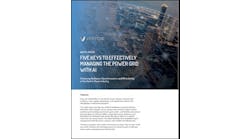June 3, 2013
When New York City Mayor Michael Bloomberg leaves office in January, green building advocates lose a strong ally. But they are determined to make sure his shoes are filled to their liking.
To that end, a coalition of environmental and real estate interests are asking candidates to endorse their plan, “Green Building Roadmap for NYC’s Next Mayor,” which offers steps to further the city’s energy efficiency efforts.
Those unfamiliar with Bloomberg’s agenda may be surprised to hear the term ‘green’ ascribed to New York City. After all, “soot” is the moniker Elizabeth Gilbert came up with in the movie, “Eat, Pray, Love,” when asked by a group of Italians for a word that embodies New York.
Truth be told, when the numbers are crunched, New York turns out to be one of the nation’s most energy efficient cities, largely because of its heavy use of mass transit and its density (about 1 million buildings in 300 square miles).
“People are surprised to see New York City as a leader on environmental issues,” said Russell Unger, executive director of the Urban Green Council, which led the roadmap effort. “We can hold our own against any city traditionally seen as a leader.”
What are the city’s bragging points?
Under Bloomberg, New York became one of a handful of US cities where privately owned buildings must publicly report their energy and water use. The effort is seen as a way to shame the energy wasters into action, boost value for the green buildings, and bring greater transparency to real estate transactions.
Bloomberg’s administration also has introduced a model commercial lease that gets at the notorious ‘split incentive’ problem for rental properties. Since renters are responsible for paying utility bills, building owners have little financial reason to invest in energy efficiency upgrades. The owner receives no financial return. The model lease solves this problem by offering a formula for owners and renters to share the bill savings.
New York is working on the soot problem too. It turns out it is not cars and trucks that create most of the city’s soot – as many believe. About 86 percent of the soot comes from one percent of the city’s buildings, those that use dirty heating fuel. The city has mandated that building owners phase out use of the low-grade oil.
Urban Green’s new roadmap puts forward a range of ideas that build upon these programs. For example, the plan emphasizes bettering school facilities to make them healthier. It updates school construction specs, improves school building maintenance and waste management, and encourages use of better heating systems.
The plan also encourages construction of high performance buildings by streamlining permit applications. And it brings to smaller buildings some of the same energy analysis reporting required of the city’s largest buildings.
What happens if a mayoral candidate decides not to support the road map? Unger said that group won’t necessarily be making a big deal about any who don’t sign on. But it will make known those who do.
He points out, too, that the road map is backed by an unusual coalition of environmental and commercial interests, groups that often don’t see eye-to-eye, but do agree on green buildings since they offer air, health and economic betterment. Urban Green is joined, for example, by the Real Estate Board of New York and the New York Building Congress in pushing the roadmap. It’s the kind of coming together of groups that political candidates like on their side.
The mayor’s race could prove instructive beyond New York City. Buildings offer enormous opportunity for energy savings. Urban voters are becoming increasingly aware of the value of living and working in energy efficient environments. If Urban Green’s campaign gains attention in the New York race, we may see the political currency of green buildings rise in other cities as well.
Elisa Wood is a long-time energy writer whose work has been picked up by CNN, the New York Times, Reuters and the Wall Street Journal Online. See her articles here: http://www.realenergywriters.com/elisa-wood/







